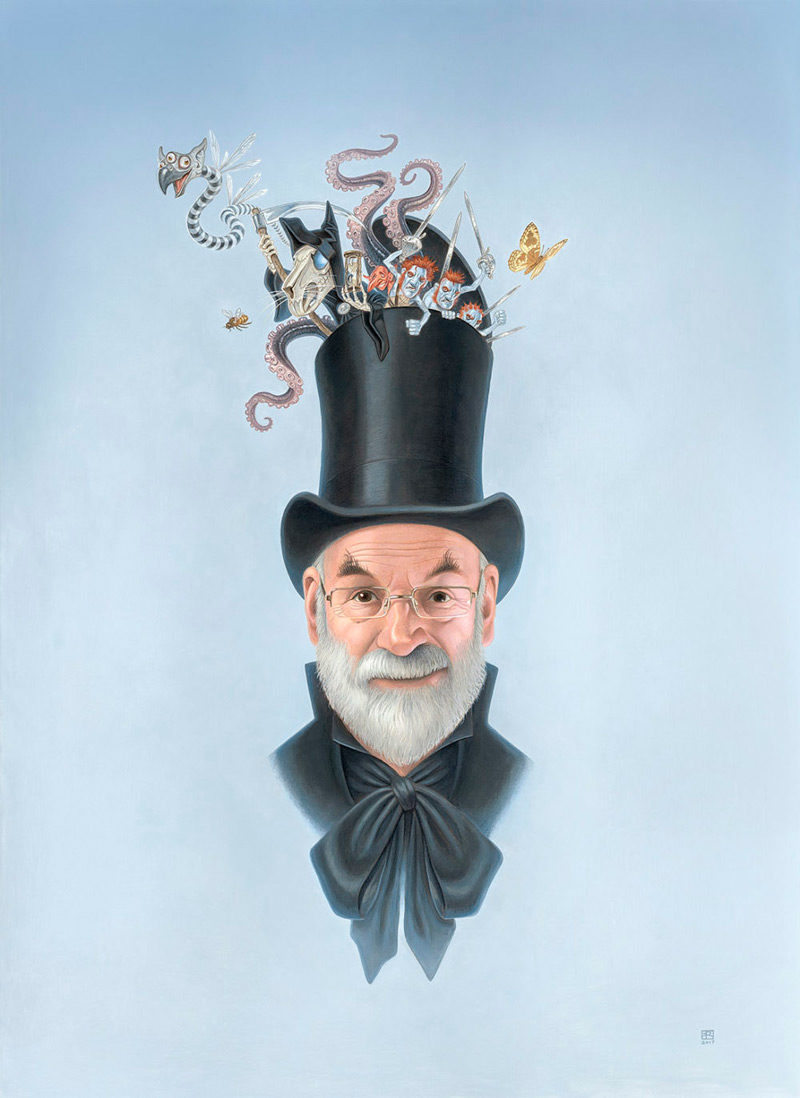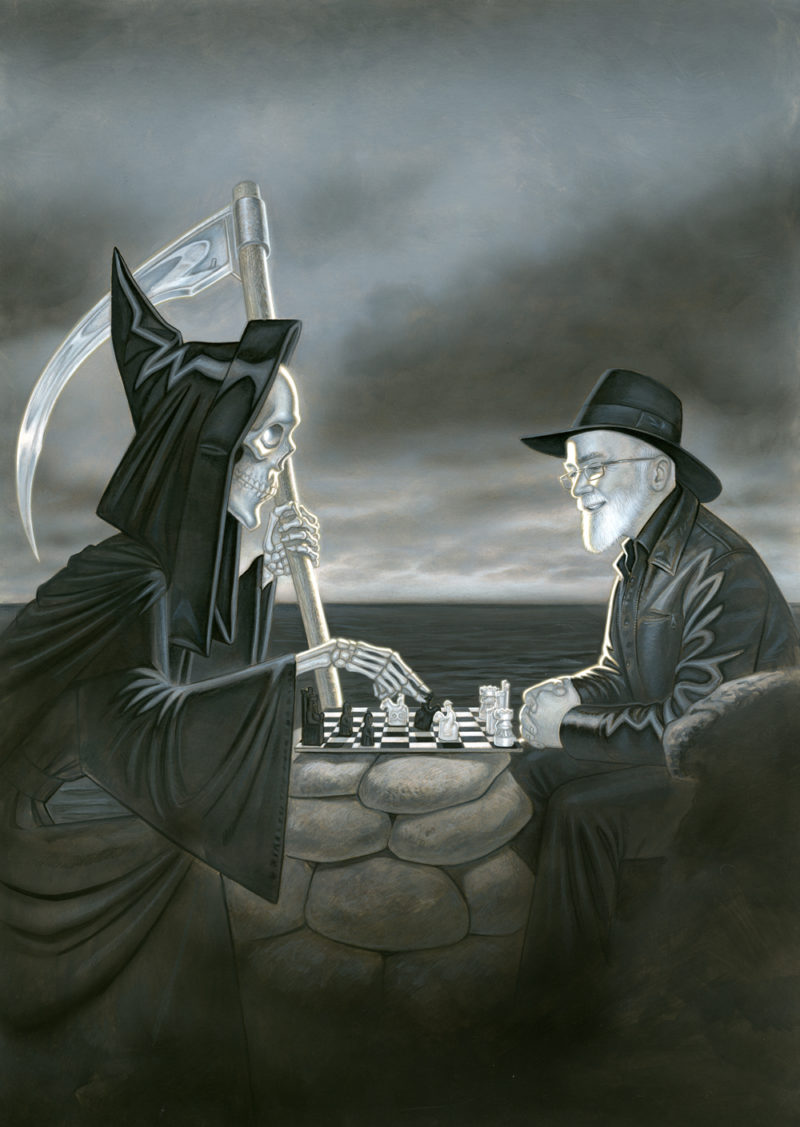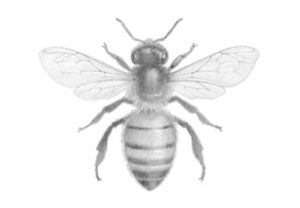
1948 – Terry Pratchett was born on April 28th in Beaconsfield, Buckinghamshire, the only child of David and Eileen Pratchett.
1962 – Aged thirteen, Terry’s first story, Business Rivals, was published in the school magazine and commercially the following year. He used the fee of £14 to buy his first typewriter.
1965 – He left school aged seventeen and worked as a journalist for the local newspaper, the Bucks Free Press (where he saw his first dead body on his first day as a roving reporter).
1968 – Terry married his sweetheart Lyn Purves and in 1970 they moved to a cottage in Rowberrow, Somerset.
1970 – He started work as a reporter at the Western Daily Mail.
1971 – His first novel, The Carpet People, was published by Colin Smythe, who later became his agent. The book was based on stories written for the children’s section of the Bucks Free Press. The launch party was held in London at Heal’s carpet department.
For the next few years Terry continued to work as a journalist, moving to the Bath & West Evening Chronicle in 1973.
1976 – Terry and Lyn’s daughter, Rhianna, was born. The same year his science fiction novel The Dark Side of the Sun was published, followed by Strata in 1981 (the latter is set upon a circular, flat earth). Both books were written on long winter evenings when he got home from work.
1979 – Terry was appointed publicity officer for the Central Electricity Generating Board, where he remained until 1987. During this time, he wrote the first four Discworld novels, The Colour of Magic, The Light Fantastic, Equal Rites and Mort. In September 1987, after finishing Mort, he decided to give up his job at the CEGB and devote all his time to writing. He was then contracted by Gollancz to write a further six Discworld books and Eric – a novella illustrated by Josh Kirby, who illustrated the Discworld covers from 1985 until his death in 2001.
1987 – Terry met the young journalist, Neil Gaiman. Their collaboration over the following years resulted in Good Omens, which was published in May 1990. The television adaptation by Neil, starring Michael Sheen and David Tennant, was released as a six-part award-winning series by Amazon Prime and the BBC in 2019.
1990s – Terry Pratchett was recognised as Britain’s best-selling living fiction writer, with sales running at over 3 million books per annum. He was writing an average of two books a year. His wide-ranging and eclectic interests are reflected in his books, which are littered with esoteric ideas and wisdom – from bee-keeping, folklore and cheese-making, to quantum mechanics, astronomy and the finer aspects of Morris dancing. In 1993 the family moved to a ‘doomsday manorette’ in the village of Broad Chalke near Salisbury. In his fiftieth year he was appointed an Officer of the Order of the British Empire, (despite initially suspecting it was an elaborate hoax).

2000 – In the millennium year, Terry’s 25th Discworld novel, The Truth, was published.
2001 – Sadly, Josh Kirby died. Terry, therefore, asked Paul Kidby to take over illustrating the book covers. Paul had been working with Terry since 1993, creating artwork for diaries, calendars and various publications, including The Last Hero, so the fans were already familiar with and enthusiastic about his work.
2002 – Terry won the Carnegie Medal for his children’s book The Amazing Maurice and His Educated Rodents. Despite the many other awards, honorary degrees (and his knighthood that followed), he maintained that this was the award he was most proud of. He went on to receive many literary awards, ten honorary doctorates and the World Fantasy Award for Life Achievement, eventually earning the full title of Professor Sir Terry Pratchett, OBE, Blackboard Monitor, Adjunct of the Oscar Wilde Centre for Irish Writing and the School of English at Trinity College Dublin.
2007 – Terry was diagnosed with a rare form of Alzheimer’s disease, known as Posterior Cortical Atrophy. He began a tireless campaign to raise awareness of the disease, which he called his embuggerence. He also continued writing and in the subsequent eight years penned a further twelve best-selling novels.
2009 – He was knighted by the Queen for services to literature. He used this as good reason for forging his own knightly sword – Thunderbolt Iron – using iron he smelted himself.
2011 – Terry delivered the annual Richard Dimbleby Lecture in 2011 (read by Tony Robinson), where he spoke about his battle with Alzheimer’s and his campaign to reform the law on assisted dying. He also presented a BAFTA- and Emmy-winning documentary on the same theme, ‘Choosing to Die’.
2015 – Terry died peacefully at home on March 12th, with his family around him and his cat asleep on the bed. His final and 41st Discworld novel, The Shepherd’s Crown, was published posthumously later that year.
2017 – The hard drive containing his unfinished novels was crushed by the six-and-a-half-tonne Steamroller, Lord Jericho, in line with Terry’s last wish that the work be either crushed by a steamroller or fired into space. His assistant and friend, Rob Wilkins, chose the former, having decided that launching a rocket might be impractical.
In her tribute to Terry, Booker Prize-winning novelist A. S. Byatt wrote that ‘No writer in my lifetime has given me as much pleasure and happiness.’
Working with Terry was a life-enriching experience for me, both professionally and personally. He had so much to say and do, books to write, orang-utans to save, campaigns to wage. His creative energy was irrepressible, always questing and dynamic – brimming over with ideas and plots that needed pinning down. Never one to sit back, Terry had so much that he wanted to achieve, and in the final years, as he was all too aware, there just wasn’t enough time.
If I could speak to Terry again, I’d thank him for writing the books that are my greatest source of creative inspiration, and for the belief and encouragement he showed by giving me the fantastic opportunity to illustrate his writing. I’d thank him for the laughs and friendship we shared too.
I remember snippets of our conversations about folklore, astronomy, gardening and recipes for nettle soup. We shared an affinity for the chalk downlands where we both lived for a time, the landscape seemed to exert a creative energy for us both. My dog and I tramped many of the ancient drove roads that traverse the grassy backbone of the downs, I knew well the wide skies, the far-reaching views and the leaping hare that he described. Blue butterflies, skylarks, soaring buzzards and harebells in the close-cropped turf were all observed on my walks, and many a flint and fossil weighted my pockets – including the shepherd’s crown.
